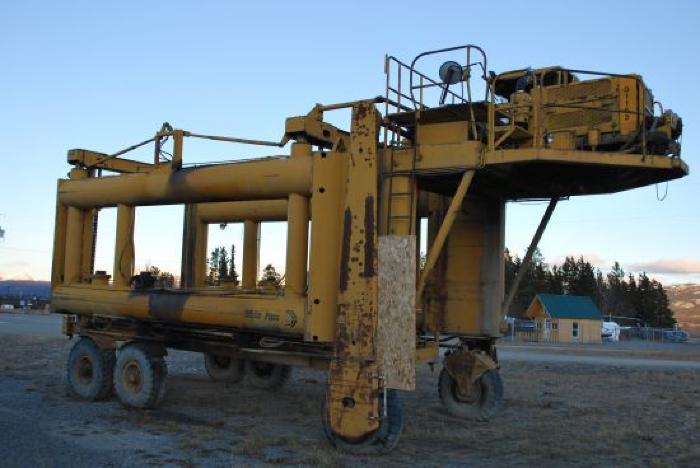Containers (blank sub-class)
Object
2010.4.1
Straddle Carrier
One of six straddle carriers that were used on the WP&YR. Large yellow wheeled sea can mover and lifter.
Driver's seat and door gaskets are held in inside cold storage L-1.
Driver's seat and door gaskets are held in inside cold storage L-1.
One pioneering railway was the White Pass and Yukon Route, which acquired the world's first container ship, the Clifford J. Rogers, built in 1955, and introduced containers to its railway in 1956. In the United Kingdom the modernisation plan and in turn the Beeching Report strongly pushed containerisation. The British Railways freightliner service was launched carrying 8' high pre-ISO containers. The older wooden containers and the pre-ISO containers were rapidly obsoleted by ten foot and twenty foot ISO standard containers, and as time went on by forty foot containers and larger.
Early, early days...
Intermodal transportation goes back to the 18th century and predates the railways. Some of the earliest containers were those used for coal shipping on the Bridgewater Canal inEngland in the 1780s. Coal containers (called 'loose boxes') were soon deployed on the early railways and used for road/rail transfers (road at the time beinghorse drawn). Examples of wooden coal containers being used on railways go back to the 1830s on the Liverpool and Manchester Railway. In 1841 Isambard Kingdom Brunel introduced iron containers to move coal from the vale of Neathto Swansea Docks. By the outbreak of the First World Warthe Great Eastern Railway was using wooden containers to trans-ship passenger luggage
between trains and sailings via the port ofHarwi ch. The early 1900s saw the first adoption of covered containers, primarily for the movement of furniture and intermodal between road and rail. A lack of standards limited the value of this service and this in turn drove standardisation. In the USA such containers, known as "lift vans', were in use from early as 1911.
Accessed from http://scr.bi/bwAWmX, November 8, 2010.
Early, early days...
Intermodal transportation goes back to the 18th century and predates the railways. Some of the earliest containers were those used for coal shipping on the Bridgewater Canal inEngland in the 1780s. Coal containers (called 'loose boxes') were soon deployed on the early railways and used for road/rail transfers (road at the time beinghorse drawn). Examples of wooden coal containers being used on railways go back to the 1830s on the Liverpool and Manchester Railway. In 1841 Isambard Kingdom Brunel introduced iron containers to move coal from the vale of Neathto Swansea Docks. By the outbreak of the First World Warthe Great Eastern Railway was using wooden containers to trans-ship passenger luggage
between trains and sailings via the port ofHarwi ch. The early 1900s saw the first adoption of covered containers, primarily for the movement of furniture and intermodal between road and rail. A lack of standards limited the value of this service and this in turn drove standardisation. In the USA such containers, known as "lift vans', were in use from early as 1911.
Accessed from http://scr.bi/bwAWmX, November 8, 2010.
